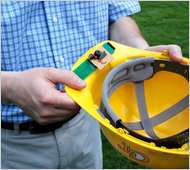July 20, 2010 weblog
Radio Waves: Alternative Power Source

Credit: Jochen Teizer
(PhysOrg.com) -- Researchers at Duke University are harvesting ambient radio waves to power small microprocessor devices that consume very little energy. Devices such as sensors that monitor critical environmental changes can be powered from radio waves.
Dr. Matt Reynolds, an assistant professor at Duke University, heads the electrical and computer department. Matt has demonstrated a low power device that is fitted into a hard-hat. Called a SmartHat, the device sounds a beeper that warns when dangerous equipment is nearby on a construction site.
The radio waves are harvest from wireless network transmitters installed on backhoes and bulldozers; they are used to keep track of their location. The low power sensor is used to monitor the direction and strength of the radio signal and warns the hard-hat wearer if they are too close.
Matt and his associates are inventing devices that consume so little power that batteries aren’t require to run them. Ambient radio waves are sufficient to operate these devices equipped with low power microprocessors.
Powercast is a company that sells radio wave transmitters and receivers that use radio waves to operate low power devices. The company recently released a receiver for charging battery-free wireless sensors; the receiver powers modules that include microcontrollers from Microchip Technology.
Because radio waves spread and lose their energy rapidly, this technology hasn’t been explored very much. With the recent advancements in silicon technology, tiny amounts of electricity can now be made to do useful work.
At Intel, Dr. Smith is exploring the use of electromagnetic radiation and creating an electronic "harvester" of ambient radio waves. The harvester collects enough energy from a TV station that’s approximately 2.5 miles from the lab to run a temperature and humidity sensor. The device collects enough power to produce about 50 microwatts of power that’s sufficient to operate many sensors. In comparison a solar powered calculator only consumes about 5 microwatts.
Dr. Reynolds of Duke University stated: “We are on the cusp of an explosion in small wireless devices than can run on alternatives to battery power. Devices like this can live on and on."
© 2010 PhysOrg.com



















